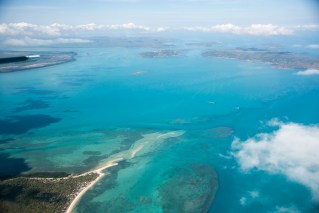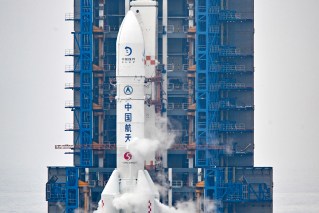NASA’s towering new Moon rocket has blasted off from Florida on its debut flight, a crewless voyage inaugurating the US space agency’s Artemis exploration program 50 years after the final Apollo Moon mission.
The 32-story Space Launch System (SLS) rocket surged off the launch pad from the Kennedy Space Centre in Cape Canaveral to send its Orion capsule on a three-week test journey around the Moon and back without astronauts aboard.
Liftoff came on the third attempt at launching the long-delayed, multibillion-dollar rocket, after 10 weeks beset by numerous technical mishaps, back-to-back hurricanes and two excursions trundling the spacecraft out of its hangar to the launch pad.
Dubbed Artemis I, the mission marks the first flight of the SLS rocket and the Orion capsule together, built by Boeing Co and Lockheed Martin Corp, respectively, under contract with NASA.
Tweet from @NASA
Late in the countdown on Tuesday night, a new potential problem emerged as NASA officials reported what appeared to be a hydrogen leak in the rocket’s upper-stage fuel lines, leading launch managers to assemble a special “red team” of technicians to visit the pad with the goal of tightening a key connection.
A short time earlier, NASA chief Bill Nelson had sounded a note of optimism amid fuel-loading operations and other pre-flight activities that had by all accounts gone smoothly.
“I’m feeling good,” he told Reuters. “But you don’t go until it’s ready, and this is a test flight.”
Launch attempts on August 29 and September 3 were aborted because of fuel line leaks and other technical problems that NASA has since resolved.
When moored to its launch pad last week, the rocket endured fierce winds and rains from Hurricane Nicole, forcing a two-day flight postponement.
Tweet from @NASAGroundSys
The Artemis I countdown climaxed with the rocket’s four main R-25 engines and its twin solid-rocket boosters roaring to life, sending the spacecraft streaking skyward and lighting up the night sky over Florida’s central Atlantic coast.
About 90 minutes after launch, the rocket’s upper stage is designed to loft Orion out of Earth orbit on course for a 25-day flight that will bring it to within 100 kilometres of the lunar surface before sailing 64,374 kilometres beyond the Moon and back to Earth.
The capsule is expected to splash down on December 11.
If the mission succeeds, a crewed Artemis II flight around the moon and back could come as early as 2024, followed within a few more years by the program’s first lunar landing of astronauts, one of them a woman, with Artemis III.
Although no people were aboard, Orion carried a simulated crew of three – one male and two female mannequins – fitted with sensors to measure radiation levels and other stresses that astronauts would experience.
A top objective is to test the durability of Orion’s heat shield during re-entry as it hits Earth’s atmosphere at 39,429km/h, or 32 times the speed of sound, on its return from lunar orbit – much faster than re-entries from the space station.
Tweet from @NASA
Dubbed Artemis I, the mission marks the first flight of the SLS rocket and the Orion capsule together, built by Boeing Co and Lockheed Martin Corp, respectively, under contract with NASA.
Named for the ancient Greek goddess of the hunt – and Apollo’s twin sister – Artemis aims to return astronauts to the Moon’s surface as early as 2025.
Twelve astronauts walked on the Moon during six Apollo missions from 1969 to 1972, the only spaceflights yet to place humans on the lunar surface.
The new Moon program has enlisted commercial partners such as Elon Musk’s SpaceX and the space agencies of Europe, Canada and Japan to eventually establish a long-term lunar base as a stepping stone to even more ambitious human voyages to Mars.
NASA’s Office of Inspector General has projected total Artemis costs at $US93 billion by 2025.
-Reuters








